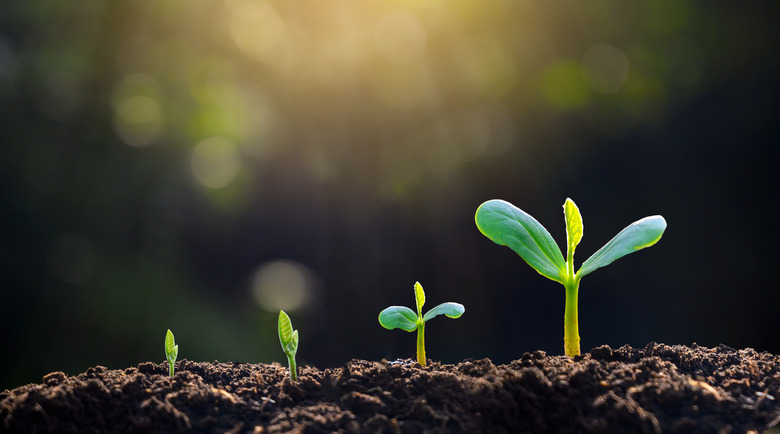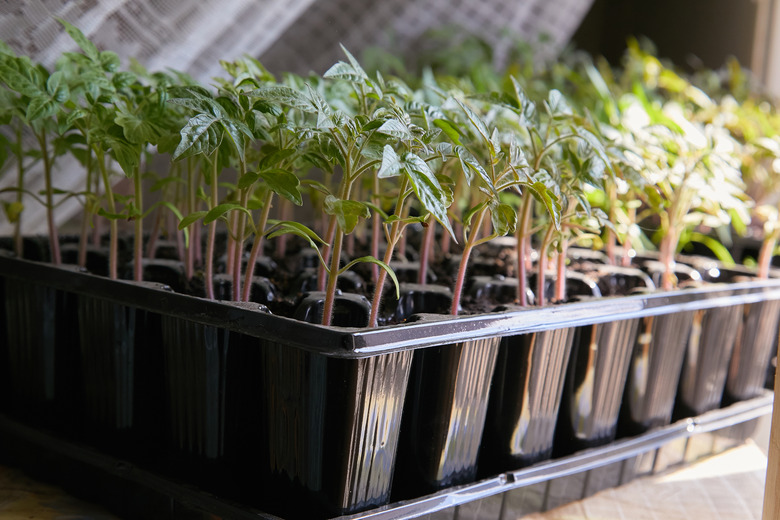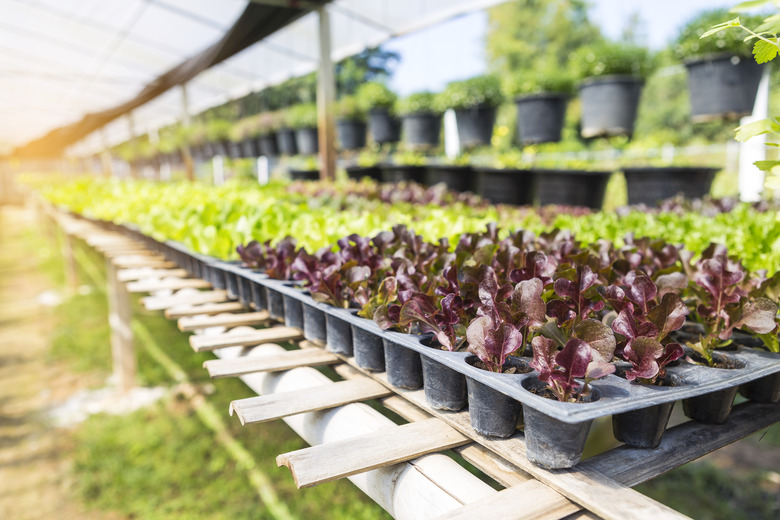Seed Starting Vs. Transplanting Seedlings
We may receive a commission on purchases made from links.
With rare exception, gardeners have a choice of growing plants from potted seedlings (often called "transplants") purchased at a garden store or home center or by seed starting with seeds that are either purchased or collected from plants already growing in their garden. Each method has advantages and disadvantages, but more often, it boils down to the type of plant you want to grow. Some plants are much more practical to grow from nursery seedling transplants, while for others, it makes far more sense to start seeds that are sown directly in the garden.
Transplanted Seedlings Mature Faster
Transplanted Seedlings Mature Faster
Probably the single biggest advantage to transplanting nursery-grown seedlings is that your plants will achieve maturity much faster. This is an advantage with many annual plants because they may begin flowering earlier in the season, depending on the size of seedlings and the time you transplant them, compared to direct-sowing seeds. Many seed-grown perennials will have a hard time reaching flowering or fruiting maturity in a single growing season, so if you want results in the first year of planting, it's best to buy container plants at the nursery, which will generally reach flowering/fruiting maturity in the first season. These nursery plants may already be 4 or 5 years old when you transplant them.
Speed to maturity is even more important with shrubs and trees. While many of these can be grown from seeds, planting one this way involves several years of waiting for the plant to achieve modest sapling stature and often a decade or more until trees mature enough to provide shade, for example. Thus, trees and shrubs are almost always purchased when they are already several years old, either in nursery containers, in balled-and-burlapped form or as bare-root plants.
There are, however, some perennial plants that grow fast enough to make seed-starting practical. Hollyhock (technically a biennial), lupine and coneflower are among the plants that are easy to grow from seeds, although you may not see flowers on these plants until the year after starting from seed. Likewise, there are some warm-weather annual plants that are relatively slow-growing, and for these, it makes sense to buy nursery plants that have been given a head start in a greenhouse. Warm-weather vegetables, such as tomatoes and bell peppers, may not be practical to sow directly into the vegetable garden in cold-weather regions, so they are usually purchased as young seedlings.
Thus, the decision about whether to plant seeds or buy transplants is largely based on how fast the species matures. With fast-growing plants, planting from seeds is usually fairly practical, while slow-growing plants are usually best started from nursery transplants.
Transplanting Seedlings Is Easier
Transplanting Seedlings Is Easier
The other principal reason for transplanting seedlings is that it's just plain easier than growing plants from seeds. Growing from seeds is a tricky business for many plants, and it takes a good amount of patience to do it successfully. This is especially true for many perennial plants, which can be slow to germinate and slow to mature.
If you are starting seeds indoors, which is the preferred method for many perennials and warm-weather annuals, it requires a fair amount of space and constant attention to coax seedlings into germinating and growing into viable seedlings. You will need the space for trays of seedlings, you may need grow lights to provide adequate light and you'll need to monitor the seed trays daily. Seed starting on a broad scale is best suited for serious hobby gardeners, not those looking for instant results.
Seedlings started indoors are prone to damping off fungus and are susceptible to pest damage, and they must undergo a careful hardening off process to prepare them for outdoor planting. When starting plants from seeds, you will be lucky to achieve a germination rate of 60 to 80 percent, while success with potted transplants is often closer to 100 percent.
Seed Starting Is Cheaper
Seed Starting Is Cheaper
It is undeniable that for budget-minded gardeners, growing plants from seeds is the way to go. For example, a single hollyhock purchased in a 1-gallon container can cost $10 or $12, while a whole seed packet of 50 hollyhock seeds can cost only $3 to $10. The price advantage is less dramatic for many other plants, but for any gardener seeking to save money, planting seeds should be the favored method.
Cost savings is even more pronounced if you learn how to save seeds from plants growing in your garden. This doesn't work for all plants since some hybrid plants don't "come true" from the seeds they produce. Rather, seeds from hybrid plants may produce plants and flowers that vary widely from their parent plants. And some hybrid seeds won't even germinate. However, for many, many plants, particularly heirlooms, there is little or no reason to even buy seeds since it is very easy to collect dried flowers and extract your own seeds to replant wherever and whenever you want.
Seed Starting Offers More Options
Seed Starting Offers More Options
Many plant species are available in literally hundreds of different cultivated varieties (cultivars), but even the largest garden centers will stock at most a dozen or so different types of the most popular plants. If you want to grow some of the more unusual varieties, then buying seeds from mail-order catalogs or online retailers is the only way to go. For some plants, online purchasing is the only option.
Not All Plants Grow From Seeds
Not All Plants Grow From Seeds
Some plants, especially fruit trees and flowering shrubs, are sold as grafted plants. These are created by grafting fruit- or flower-bearing branches onto a rootstock from a hardier, more durable plant within the same plant family. A hybrid rose, for example, is never grown from seeds but is instead created by grafting canes from a highly ornamental rose onto rootstock from a sturdy wild or heritage rose. Similarly, many commercial fruit trees are grafted botanical creations and not plants that grow from seeds. A small number of herbaceous plants also fall in this category of "merged" plants.
It is easy enough to identify plants of this type, as seeds for these plants will not be available at all. This is often the case for flowering trees and shrubs, and there are a handful of other plants that don't grow from seeds. Ferns, mosses and liverworts, for example, reproduce from spores or other means rather than flowering and producing seeds. For these, your only option is to buy potted plants for transplanting unless you master the often-challenging way to propagate ferns, for example, from the spores they produce.
Some Plants Don't Transplant Well
Some Plants Don't Transplant Well
Certain plants may germinate from seeds just fine, but they don't transplant well at all, sometimes because of very fine root systems or long taproots that resent being moved. Such plants like to grow in the same place they are sown. Snapdragons, nasturtiums, spinach, beets, carrots and peas are some of the plants that grow well from seeds sown in exactly the spot you want them to grow. (They're not, however, great plants to start indoors from seeds since the transplant shock can wreak havoc with them.)
The Bottom Line
The Bottom Line
In the final measure, the choice of whether to create your garden by sowing seeds or buying nursery transplants boils down to the type of plant you want to grow and whether you place a priority on saving money or on speedy results. While not all plants give you this choice, in general, starting from seeds is cheaper but more difficult, and creating your garden from potted nursery transplants is quicker and easier but more expensive.
Pros and Cons of Seed Starting
|
Advantages |
Disadvantages |
|
Much cheaper than buying seedlings |
Plants take longer to mature |
|
Broader selection of varieties |
More difficult to grow plants |
|
Plants have better resistance to pests and diseases |
Not all plants are available as seeds |
|
More susceptible to diseases and pests |
Pros and Cons of Transplanting Seedlings
|
Advantages |
Disadvantages |
|
Plants reach maturity faster |
More expensive than planting seeds |
|
Higher success rate |
Some plants respond poorly to transplanting |
|
Fewer disease and pest problems |
|
|
Only option for most shrubs and trees |


